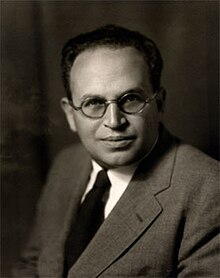Paul Lazarsfeld
| Paul Lazarsfeld | |
|---|---|
 |
|
| Born |
February 13, 1901 Vienna, Austria-Hungary |
| Died |
August 30, 1976 (aged 75) Newark |
| Occupation | Founding figure in 20th-century empirical sociology |
| Known for | social research, mathematical sociology, two-step flow of communication model, limited effects theory |
Paul Felix Lazarsfeld (February 13, 1901 – August 30, 1976) was an American sociologist. The founder of Columbia University's Bureau of Applied Social Research, he exerted influence over the techniques and the organization of social research. "It is not so much that he was an American sociologist," one colleague said of him after his death, "as it was that he determined what American sociology would be." Lazarsfeld said that his goal was “to produce Paul Lazarsfelds." The two main accomplishments he is associated with can be analyzed within two lenses of analysis: research institutes, methodology, as well as his research content itself.
Lazarsfeld was born to Jewish parents in Vienna: his mother was the Adlerian therapist Sophie Lazarsfeld, and his father Robert was a lawyer. He attended schools in Vienna, eventually receiving a doctorate in mathematics (his doctoral dissertation dealt with mathematical aspects of Einstein's gravitational theory). In the 1920s, he moved in the same circles as the Vienna Circle of philosophers, including Otto Neurath and Rudolf Carnap. He came to sociology through his expertise in mathematics and quantitative methods, participating in several early quantitative studies, including what was possibly the first scientific survey of radio listeners, in 1930–1931. In 1926 he married the sociologist Marie Jahoda. Together with Hans Zeisel they wrote a now-classical study of the social impact of unemployment on a small community: Die Arbeitslosen von Marienthal (1932; English eds. 1971). He divorced Marie in 1934 and married his colleague Herta Herzog, who divorced him in 1945.
The Marienthal study attracted the attention of the Rockefeller Foundation, leading to a two-year traveling fellowship to the United States. From 1933-1935, Lazarsfeld worked with the Federal Emergency Relief Administration and toured the United States, making contacts and visiting the few universities that had programs related to empirical social science research. It was during this time that Lazarsfeld met Luther Fry at the University of Rochester (which resulted in the inspiration for the research done in Personal Influence, written some twenty years later) and Robert S. Lynd, who had written the Middletown study. Lynd would come to play a central role in helping Lazarsfeld emigrate to the United States, and would recommend him for the directorships of the Newark Center and the Princeton Office of Radio Research. Lazarsfeld contacted the Psychological Corporation, a non-profit organization devoted to bringing the techniques of applied psychology to business, and proposed a number of projects that were rejected as not having enough commercial value or being too involved. He also helped John Jenkins, an applied psychologist at Cornell University, translate an introduction to statistics Lazarsfeld had written for his students in Vienna (Say It With Figures). Finally, he pursued research into the ideas presented in the widely read "The Art of Asking Why" (1935), which explained Lazarsfeld's concept of "reason analysis."
...
Wikipedia
